On 20 June 1941, the last day of peace, it was published an order of NKAP
(the Ministry for Aeronautical Industry) to paint all planes with a new standard
camouflage within one month.
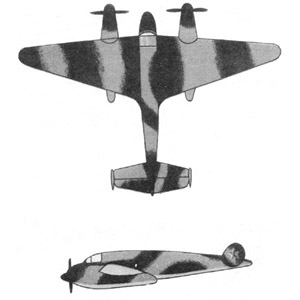
Already existing planes with uniform green uppersurfaces had to be added with matt black (A-26m oil paint for metal planes, and AMT-6 nitrocellulosic lacquer for mixed construction planes). Undersurfaces presumably preserved the original finish in A-18F or AII light blue.
For newly built planes, the instructions said to utilize matt light blue for undersurfaces (not specified what type of paint, but all previous light blue paintings were gloss, so they have to be A-28m for all-metal planes and AMT-7 for mixed construction planes).
Apart for some Yaks, the first known photos of planes with the new green/black painting scheme are dated to July 13, 1941.
Many maintenance manuals of the first years of war describe these paints: dope AMT-4 green, AMT-6 black and AMT-7 blue enamel or oil A-24m, A-26m and A-28m of the same colours. Oil colors were less utilized, also because AMT colors can adhere well to primed metal surfaces.
Despite their name (M= matt), AMT colors were semigloss when new, and turned to matt finish with ageing. Occasionally, they could have been overpainted with a layer of gloss varnish AB-4-d to improve aerodinamicity and gain some speed.
While AMT-4 and 6 were codified in July 1941, AMT-7 was codified in August 1941, and is not mentioned on earlier manuals; earlier AII light blue remained in use in parallel with the darker AMT-7 in the first years of war.
Oil enamels were intended to be sprayed on the exterior metal surfaces, even unprimed. Painting with a brush meant poor paint properties, and was allowed only as a second choice, ex. for repairs.
Prop blades were now fully painted black.
The order of June 1941 changed the national marks of planes too. Red stars, of plan tipe or with thin black outline, were now placed in six positions:
- one on each side of fuselage (not always, on twin-engined planes),
- one on each side of rudder/stabilizer,
- one on the undersurface of each wing.
Note the deletion of stars over the wings, and the introduction of new ones on the tail.
Sometimes stars were outlined with white, silver or yellow borders, but this wasn't a standard.

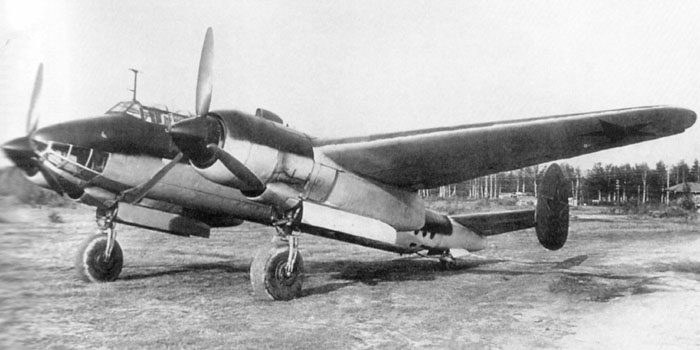
The first production Tu-2 ( VS and S) were completed in February 1942 in factory 168 in Omsk. They were equipped with M-82 engines, and arrived at the 3rd air army combat units.
On October 1942, it was ordered to stop the production, and the 80th and last plane was delivered in January 1943.
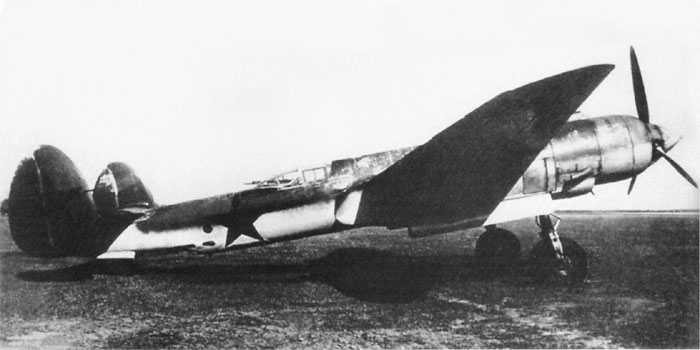
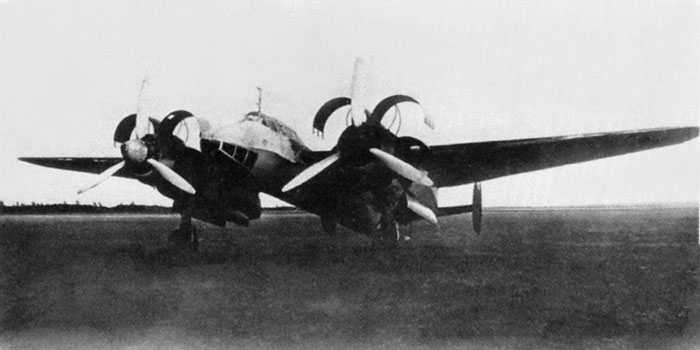
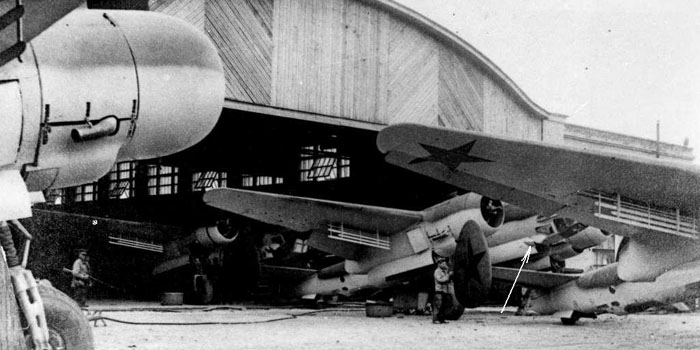
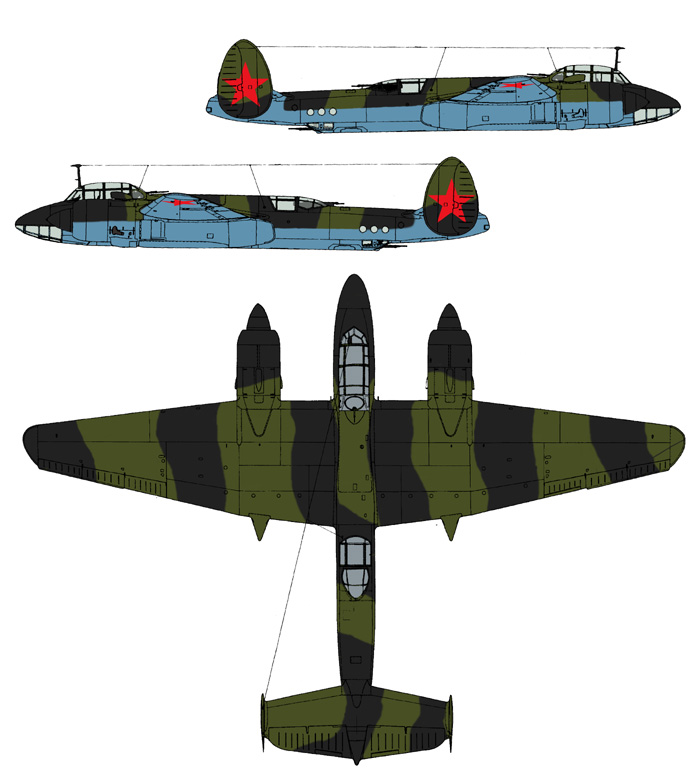
On the whole, the template of early Tu-2 VS of 1942 resembles very much the standard one for Pe-2s.
The color were probably:
black: AMT-6
green: AMT-4
light blue: AMT-7
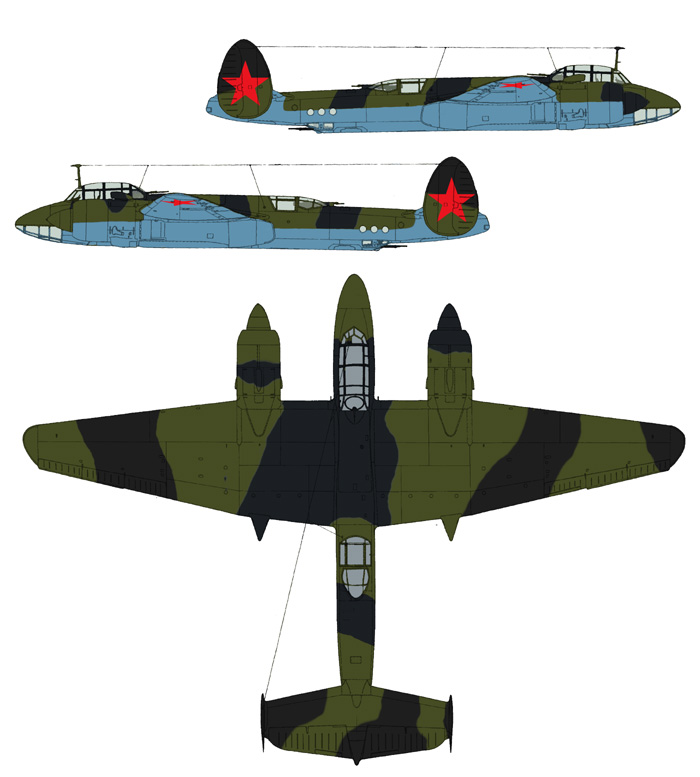
Some photos and drawing suggest the existance of a reverse pattern, where green replaced black and vice versa; this later scheme could already have been adopted in 1942, before the stop of the production at Omsk.
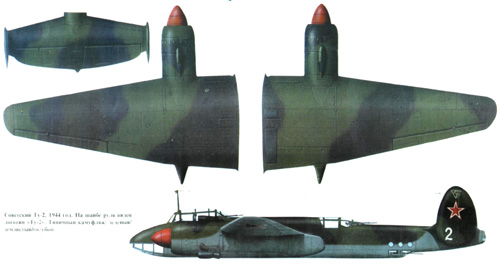
The colors probably were:
black: AMT-6 (or A-26m on metal parts)
green: AMT-4 (or A-24M on metal parts)
light blue: AMT-7 (or A-28M on metal parts)
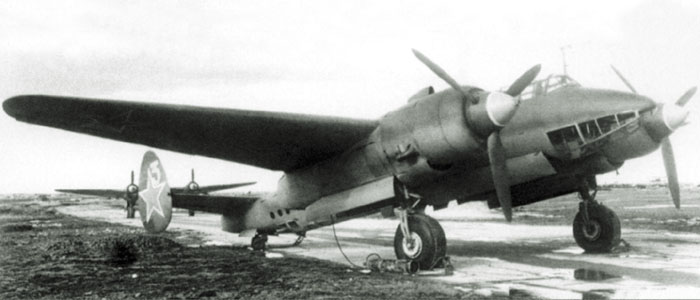
This Tu-2R was rebuilt in 1943 from an early Tu-2VS, adding large cameras in the bomb bay. It was tested and later flown in combat by 2nd DRAP.
It seems to show a 1942 black-green 'reversed' painting scheme, but its stars are already of the type introduced in late 1943. Strangely, the contrast on the nose sides looks much lower than on the tail.
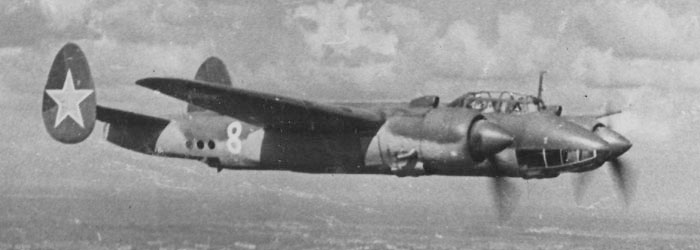
The production of Tu-2 was restarted in July/August 1943 at Factory n.23 in Moscow with the improved Tu-2S
The photo shows an operative Tu-2 S of 63 BAP flying over Moscow in 1945, immediately after the war. Strangely, although being probably produced in 1944, this plane doesn't seem to follow the camouflage introduced in August 1943 (green-dark grey-light brown) nor the factory template for Tu-2; the different contrast between bands on the nose sides and on tail suggests, anyhow, a sort of 3 tones camo. Perhaps it's only that the light brown appears unusually dark on this photo.
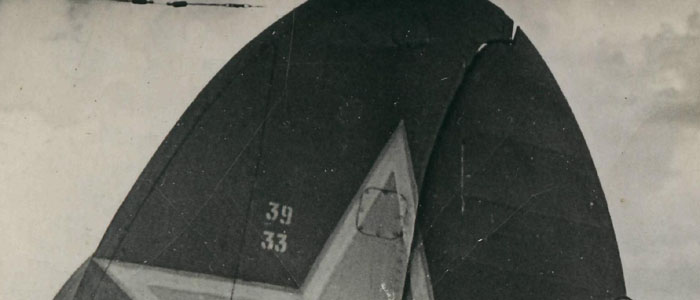
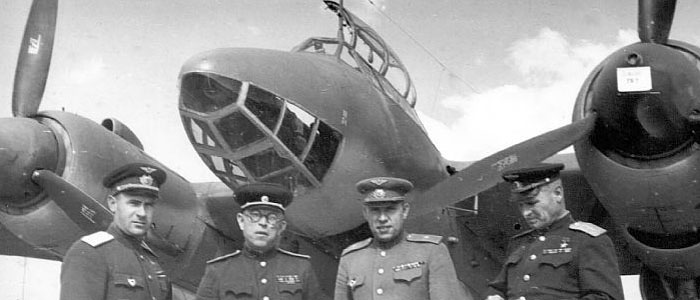
The directive n°2389/0133 of July 3, 1943, gave new instructions to paint the Soviet warplanes:
- the upper and side surfaces of all fighter aircraft were to have two colors: greyish blue and dark grey in the same scheme;
- upper and side surfaces of all types of aircraft but fighters had to be camouflaged in green, light brown and dark grey (black for Il-4 and Pe-8);
- the red stars remained in the same six positions of before, but were addictioned with a thick white outline and, more externally, with a further thin red outline.
- the directive applied to new planes and those in repair shops; it wasn't required that operative units repainted all their planes.
| Nitro lacquers for mixed construction planes | Oil enamels for all-metal planes | |
| light brown | AMT-1 | A-21m |
| dark green | AMT-4 | A-24m |
| black | not needed | A-28m (for Il-4 and Pe-8 only) |
| light blue | AMT-7 | A-28m |
| blue-grey | AMT-11 | not needed for non-fighter planes |
| dark grey | AMT-12 | A-32m |
The directive assumed that the non-fighter planes had to be delivered with the new camouflage starting from August 1, 1943; in the days before, black had to be replaced with dark grey.
In case of absence of dark grey, this would have been replaced by a mix of light blue and black.
The directive contained 15 camouflage schemes for many types, of which 2 were for Pe-2
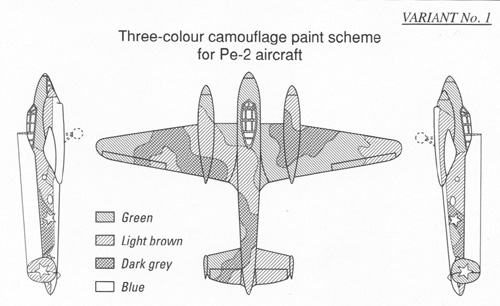
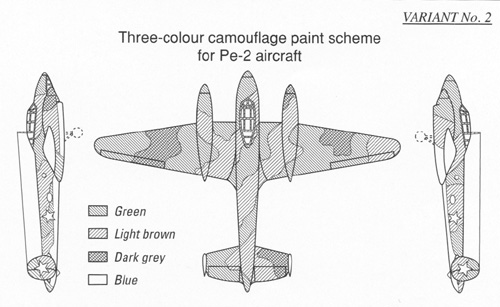
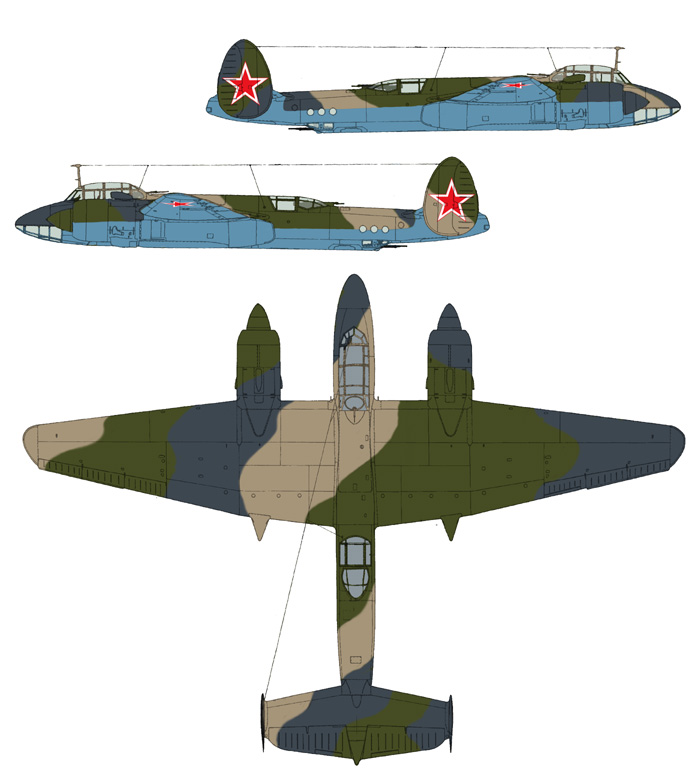
This change was contemporary to the restart of the production of Tu-2s at the factory n. 23 in Moscow.
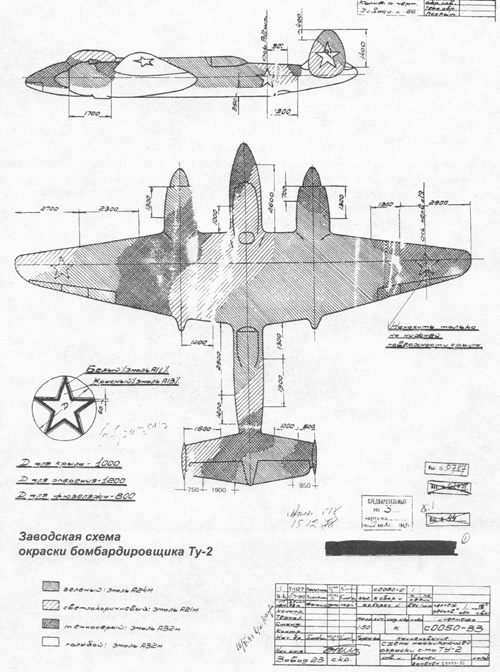
The document of NKAP doesnt provide templates for 3-shades camouflaging of Tu-2s, but here is a factory sketch (From Vaklamov and Orlov).
Left: a color drawing obtained by following the factory drawing.
Unfortunately, very few photos show planes painted with resemblance to this drawing. The thing is confusing, and isn't clear if it can be explained with the existance of a second undocumented template as on Pe-2s, Il-4s and Il-2s (as I tried to make below), or if some planes follow partially the templates for Pe-2s, or if each plane was painted in its own way; on the other hand, many partial regularities can be found comparing photos.
The most mysterious thing is that many photos show the upper wing surfaces much lighter than the fuselage and engine sides, as if they were widely oversprayed with light brown; I don't think that fading is enough to explain this.
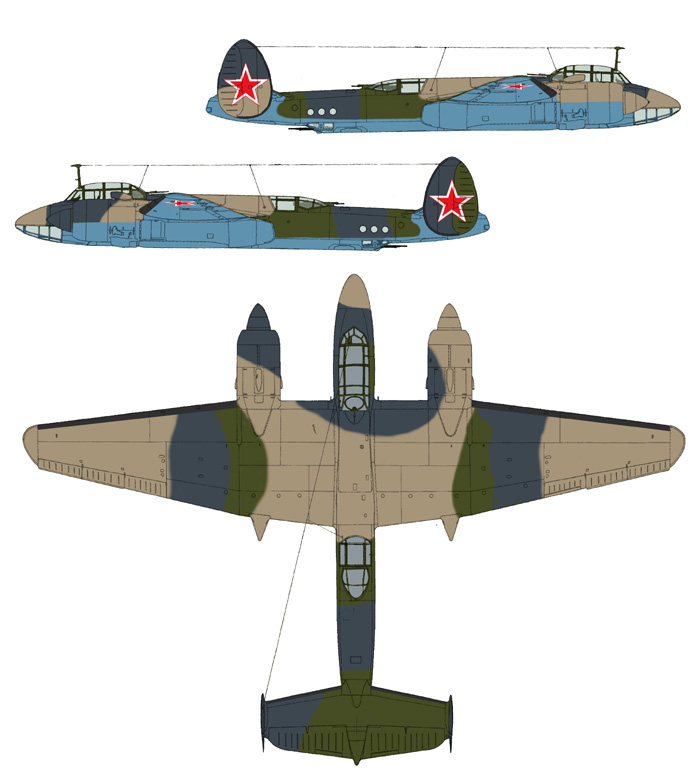
Many photos, the most of which are taken before the war, show some recurrent characteristics:
- light color on the nose, on the rear of the left engine cowling, on all the right engine cowling, over the fuselage between the wings, but not always on the rear fuselage;
- sometimes gloss finish, probably adopted after the war's end;
- sometimes the wings and tail leading edge are repainted with a dark color, possibly black, at least on late production planes.
Tu-2s production restarted after the war, still with the three-shads camo buth with glossy colors. Poswar colors should be:
Colors should be:
- dark green A-24g (AGT-4 on fabric-covered surfaces)
- light brown A-21g (AGT-1 on fabric-covered surfaces)
- dark grey A-32g (AGT-12 on fabric-covered surfaces)
- light blue-grey A-36g (AGT-16 on fabric-covered surfaces)
Please note that the scarcity and uncoherence of documents make the upper wiew a mere guess.
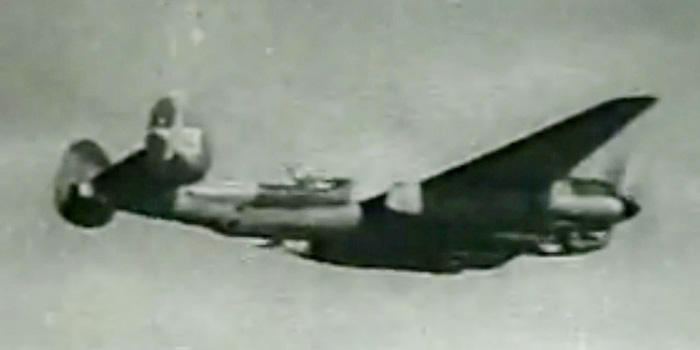

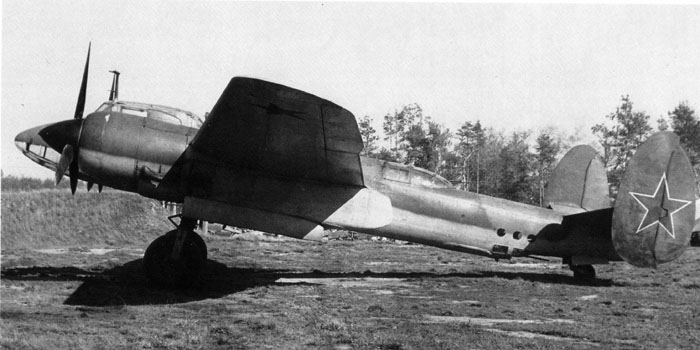
The first Tu-2D, plane 62 (n.718) during factory tests in July 1944.
The camouflage looks compatible with the template of 1943.
(From Monografie Lotnictze)
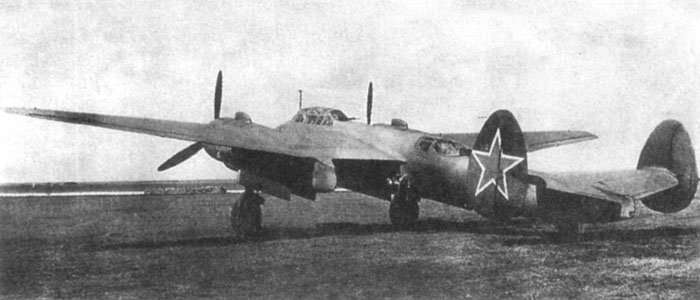
This photo of 1947 of a Tu-2S equipped with two torpedoes shows a fairly good, but not perfect, correspondance to the factory template, apart that the areas that should be dark grey appears lighter than those that should be green; perhaps this is due to a quicker fading of the dark grey. It could be casual, but the left rudder and stabilizer appear as for a black/green painted plane.
However, this is the image showing the higher respect for that pattern between those available.
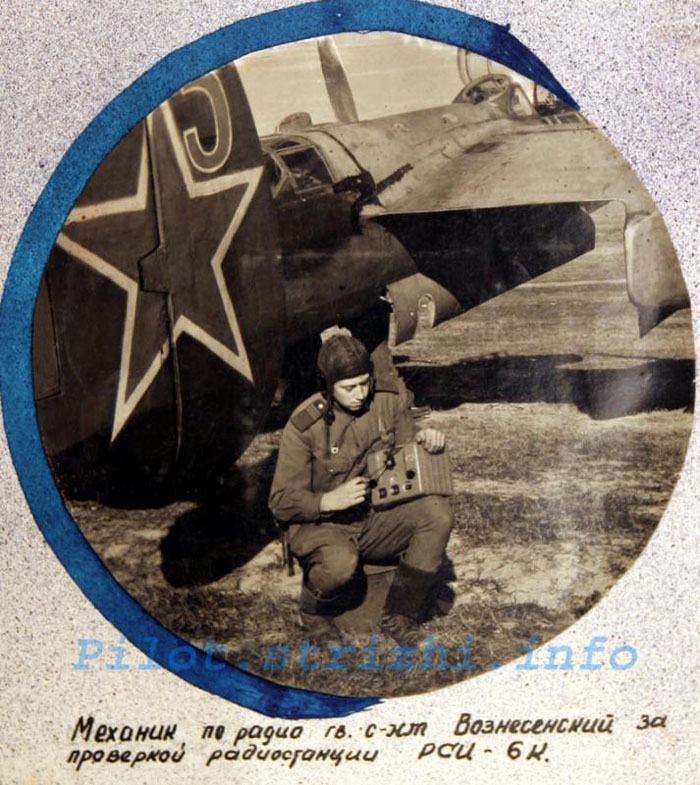
Interesting image that seems to show the use of black on this plane, aside what probably are green and light brown. As already seen on many photos, the extension of the light brown over the wings is much wider that that prescribed by the factory template.
(from pilot.strizhi.info)
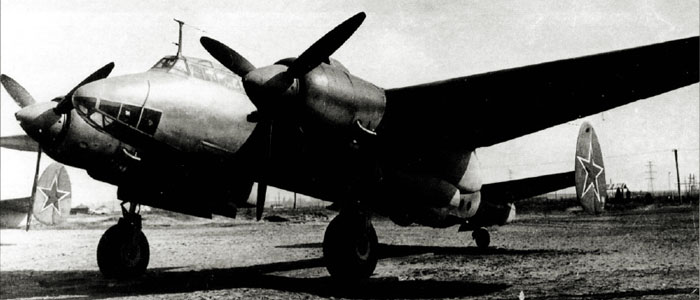
This Tu-2R of 15th ORAP (probably built at Omsk) photographed in 1945 seems not to respect the factory template, being its camo an adaptation of a green-black one.
The plane on the left looks to follow the factory template, featuring a light brown/green tail surface.
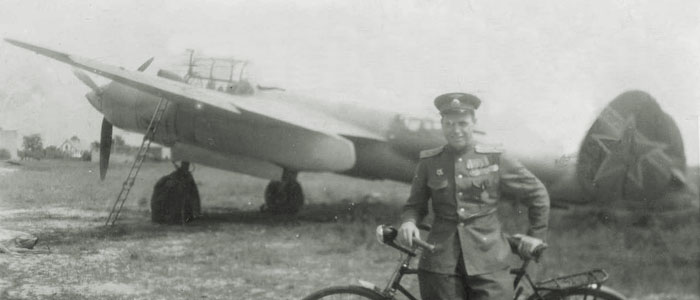
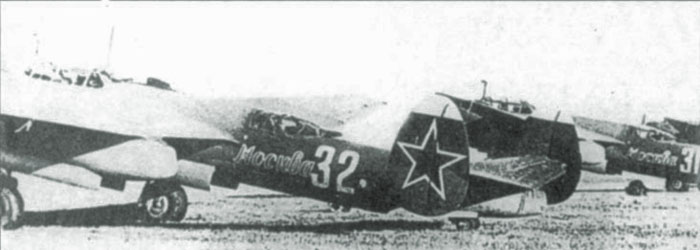

http://sovietwarplanes.com/board/index.php?topic=852.0
http://scalemodels.ru/modules/forum/viewtopic_t_6527_start_140.html
These images of summer 1944 seem to show that the camo pattern was interpreted with a lot of freedom; in particular, that light brown blotches over the wings were much more extended that what the template prescribed; or, perhaps, the colors of the wings were very faded while those on the tail and fuselage had been restored.
Below: a detail of plane 26. The man is Lieutenant AI Pogodin Aerodrome Kamisikuka, Sakhalin, September 1945.
The inscription should be:
??????
?? ?????????? ?????????
??????.
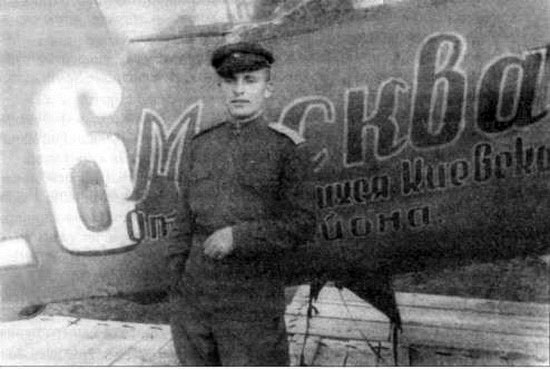
Plane of the same unit photographed after the last bombing of Berlin. The slogan says "For Peter Pervushina!"
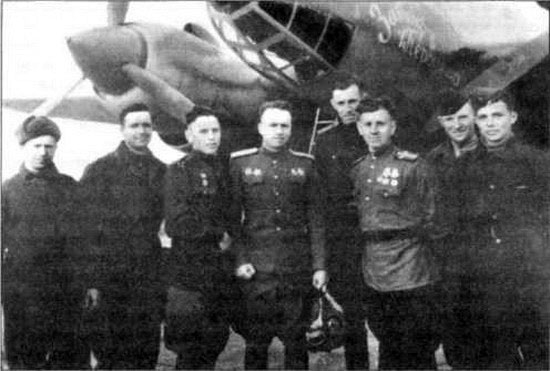

Tu-2S (blue 20?) built in Factory 23, in October 1944. The light brown painting over the wings looks extending to nearly all the wing and part of the tail. A similar look was often seen both on Tu-2 and Pe-2 in late 1944 and 1945, and its reason is unclear.
Being the photo dated before January 1945, when the new instructions prescribed blue-grey and dark grey camouflage, it is safe enough to assume that the light color wasn't blue-grey, but the light brown introduced in 1943.
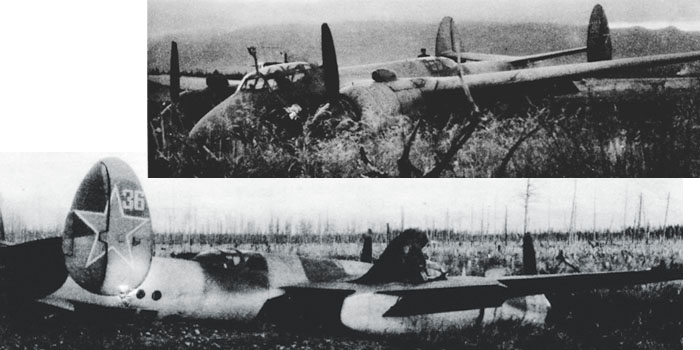
Tu-2 n°36 (factory number N° 40/31) of 454 BAP badly landed in 1945. As previous ones, this image shows a wide extension of the light color on the plane, including the nose, the engine cowlings, the most part of the wings and the tail. It could be that this plane was widely repainted in blue-grey AMT-12.
Note: in the photo below, there is a shadow resembling a camo band on the back between the canopies.
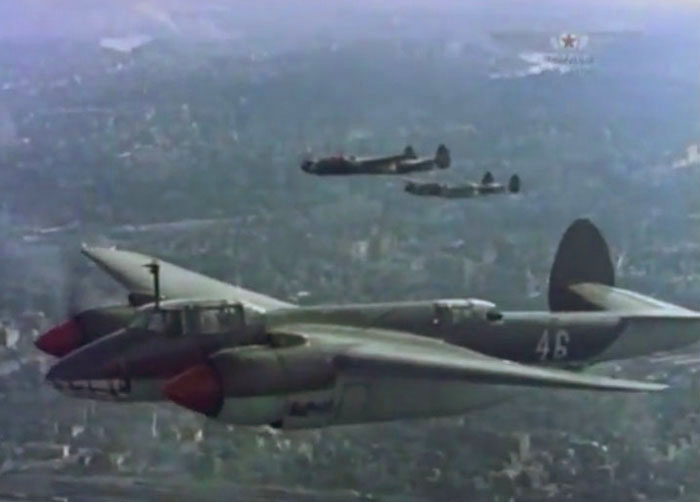
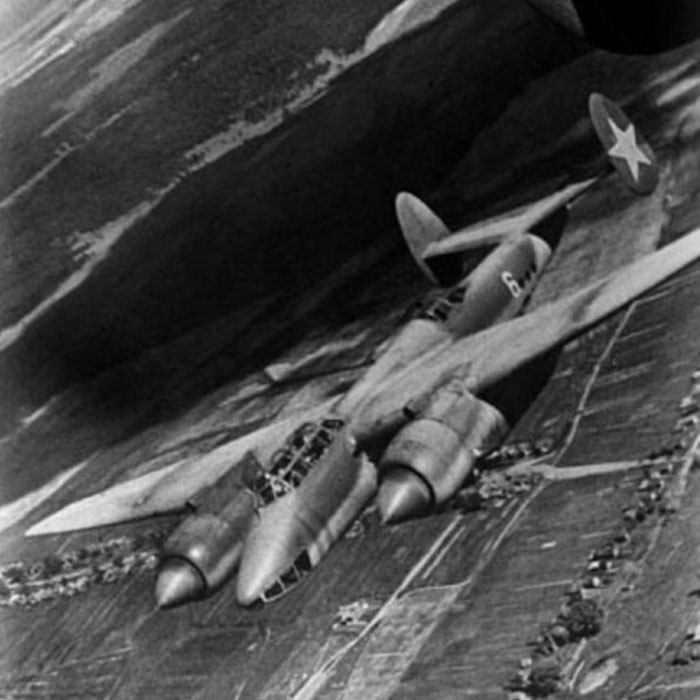
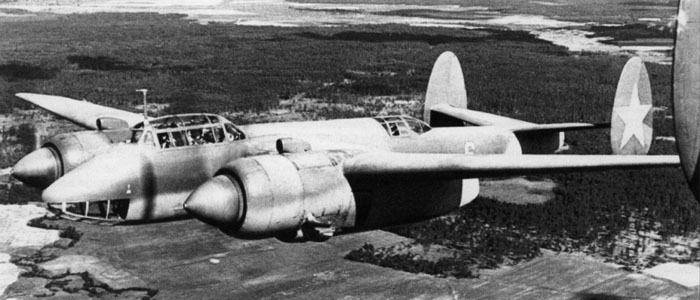
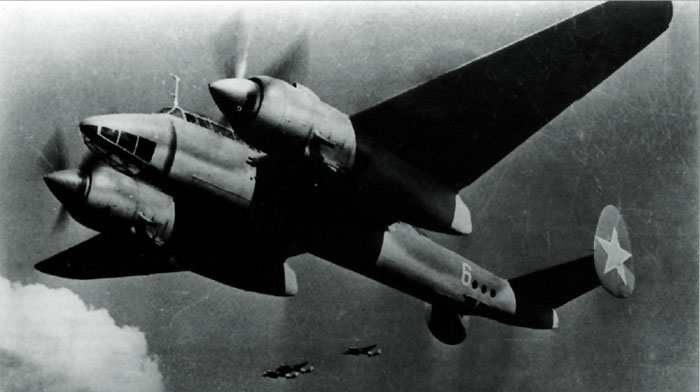
Although clear, these photos show an unusually light Tu-2S white 6 in 1945. It could be a dark grey-green- light brown camo oversprayed with blue-grey (or further light brown) on the wing tips and longitudinally on the rear fuselage and transversally on the tail. The rudder looks from another plane.
The background and the dark shade of the tail of the photographing plane confirm that the photo is not overexposed, so the colors of the plane are really very light.
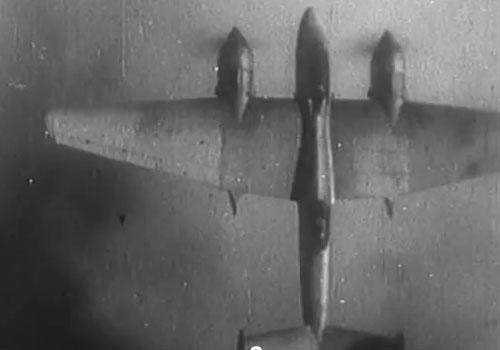
In late 1944 the Soviet Air Force had altready reached a position of superiority over the German Luftwaffe and its alleys. While Germans reverted to green/brown camouflages to hide better their planes on the ground, the Soviets decided to extend to all planes the blue grey/dark grey camouflage that has been successful for fighters since August 1943.
On October 1, 1944, the Resolution n.6339 was approved, but burocratic delays retarded its publication till January 1945.
| Nitro lacquers for mixed construction planes | Oil enamels for all-metal planes | |
| light blue | AMT-7 | A-28m |
| blue-grey | AMT-11 | A-33m |
| dark grey | AMT-12 | A-32m |
The resolution included templates for many types
of planes.
The new grey-grey template for Pe-2 was intended for the Tu-2 too. As it is traced here, it doesn't appear on any photo or wartime or postwar Tu-2.
Comparing those drawings to the photos, there are doubts if the directive was applied, and how; very few types respect the new templates, but many planes could have been updated, as suggest Vaklamov and Hornat, by repainting blue-green over green areas and dark grey over light brown areas. This would have led to a predominance of dark grey over blue-grey, but seems to be not a common case on photos.
Many types, Pe-2 and Tu-2 in particular, received wide soft repainting with a light color, leaving visible part of the previous camo; one can think that this light added color is blue-grey, even if one could have expected something darker from the description of A-33m, said darker than AMT-11. Perhaps it was sometimes surrogated with a mix of light blue and black, according to the formulas prescribed in 1943 for fighters.

Rare color image of Tu-2s, probably after the war. The most of them seem to have bands of light brown, only one of the planes, far on the left, seems to have a grey-grey livery.
Note that the closer wing looks to have a brown band where the template of 1943 doesn't show any, this could be interpreted as a confirmation of the impression give by many bw photos about the wide overpainting of wings with light brown.
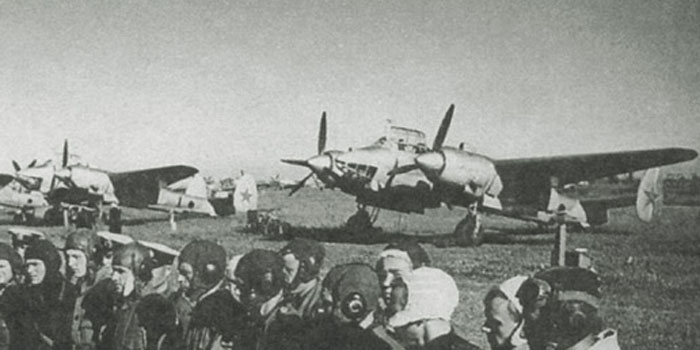
Tu-2s of a Navy unit in Far East, summer 1945.
The image can suggests the use of a blue-grey livery.
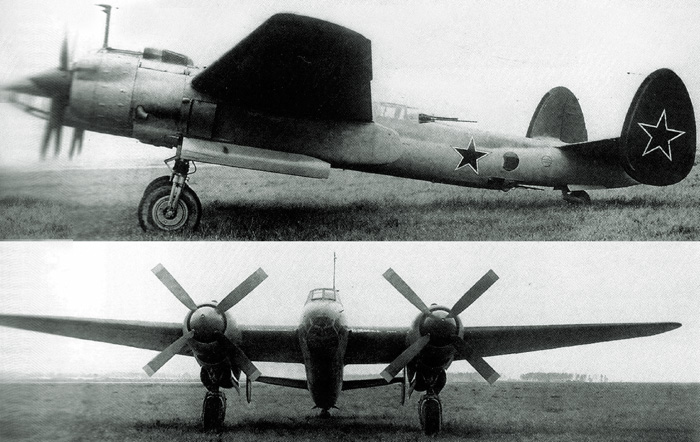
The production of Tu-2 was restarted in 1949 in factory n.39. Here are two images of a standard plane of new production, n. 10053915. Note the high demarcation line between uppersurfaces and undersurfaces.
(From Airwar)



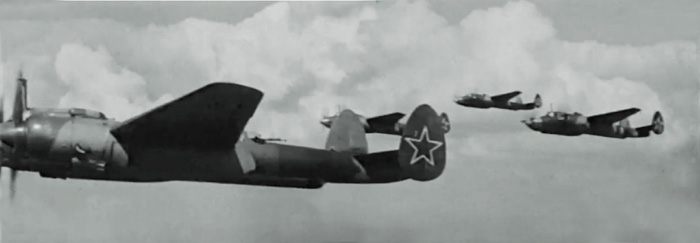
A formation of 4 Tu-2s, all with the same, mysteriously well-contrasted livery. Unfortunately the year when the image was taken is unknown, however it could be a 3-shades template alternative to the one known from the factory sketch traced below and known via the book of Orlov.
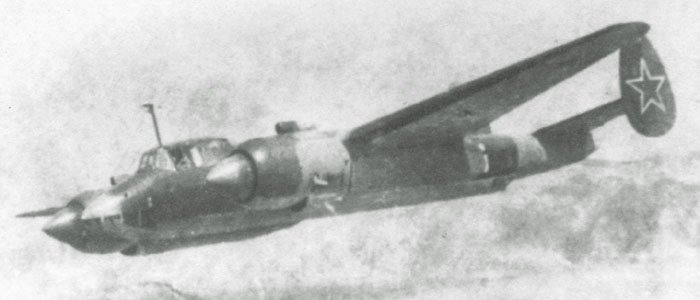
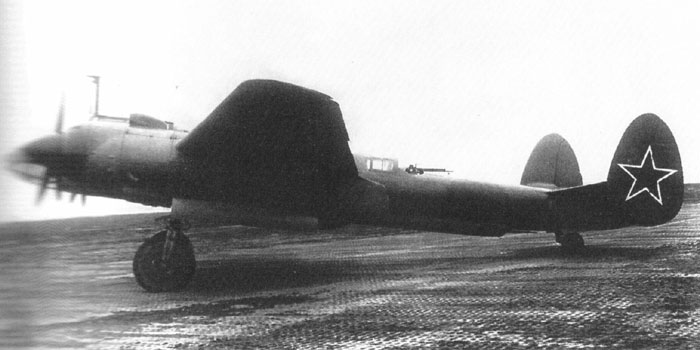
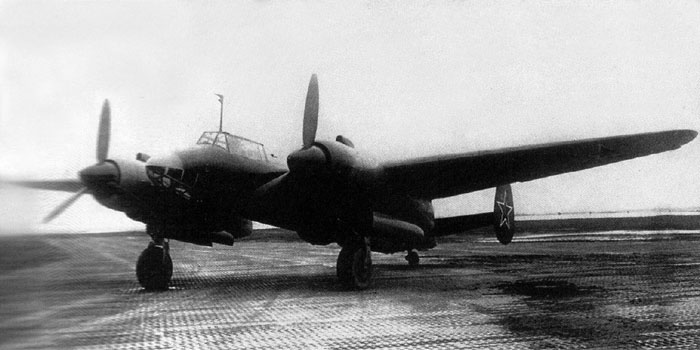
The Tu-6A (reconaissance Tu-2) n.14/58 in 1948. The pattern looks similar to the planes above.
Tu-2s built after the war preserved the wartime livery for some years, then passed to an all-green livery.
Colors should be:
dark green A-24g (AGT-4 on fabric-covered surfaces)
light brown A-21g (AGT-1 on fabric-covered surfaces)
dark grey A-32g (AGT-12 on fabric-covered surfaces)
light blue-grey A-36g (AGT-16 on fabric-covered surfaces)

This image of Tu-2 21/57 of 1944 equipped with a paravan device shows a surprisingly contrasting three-colors camouflage; note the light part visible between the wing and the gunner canopy.
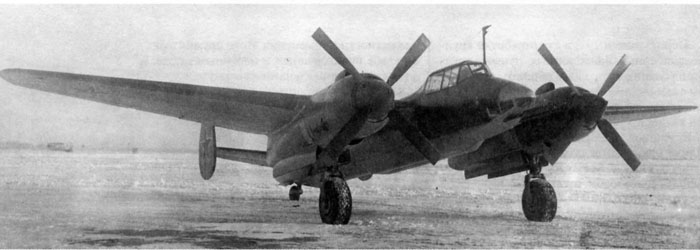
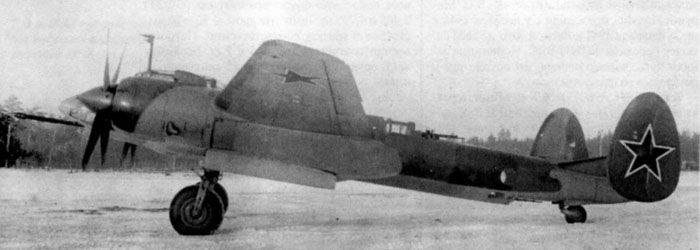
Two photos of Tu-2P armed with two guns
(from Tu-2 of Nikolai Yakubovich)
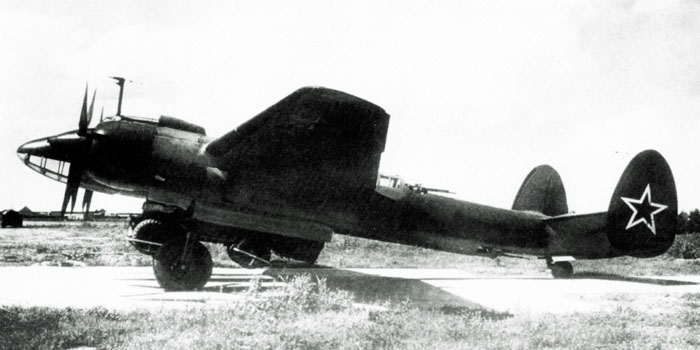
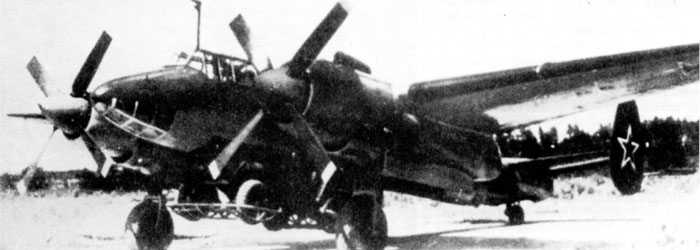
Tests of Tu-2s no.1660906 bearing a parachutable GAZ-67B vehicle in July 1949
(from Lotnicze)
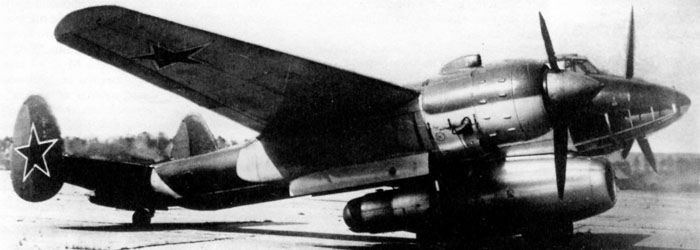
A Tu-2 utilized to test a large jet engine.
The upper livery looks overall gloss green (probably A-26g oil enamel), but the fabric-covered rudders (and, probably, elevators and ailerons) look painted with a different shade (probably nitro AMT-4 green)
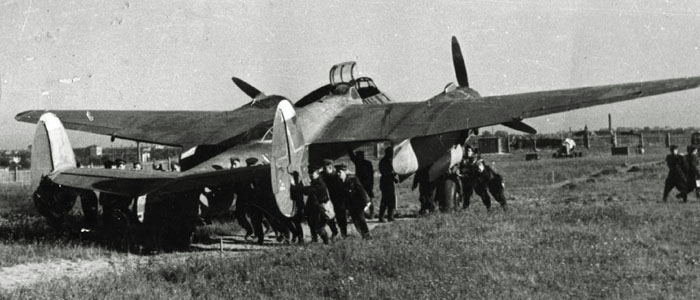
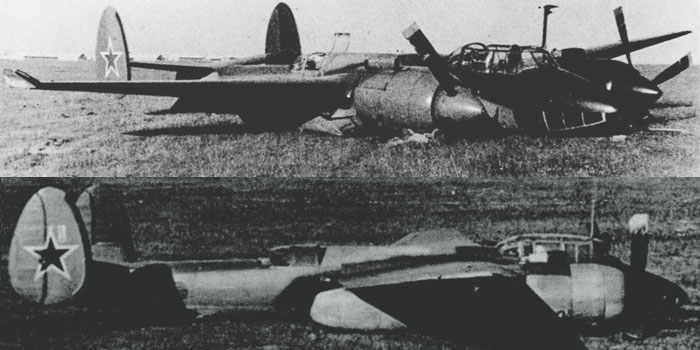
A late type Tu-2 N° 1661104 badly landed in 1950. Note the black painted parts, probably as an anti-glare measure, probably over a green/lt.blue (or grey/ lt.blue) livery.
The four-blades propeller has a yellow tip, and a thin yellow line in inner position that doesn't seem to be standard for all planes.